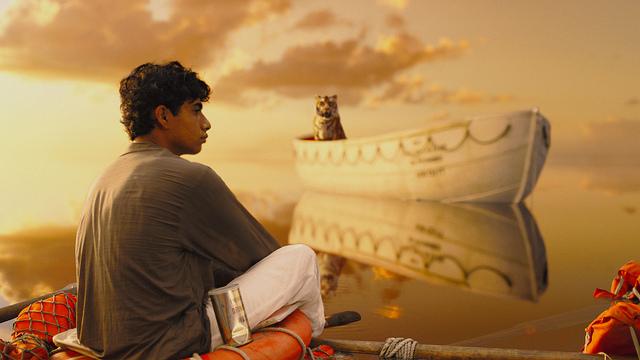MOVIE: ‘Life of Pi’ mesmerizingly beautiful
November 25, 2012
Adventure film lacks strength in meaning, but is visually masterful

What do you do when you’re trapped in the middle of the Pacific Ocean with a tiger? Apparently, you train it with a whistle.
That’s the premise of “Life of Pi,” directed by Ang Lee and based on the international bestseller by Canadian author Yann Martel. In it, Pi Patel’s (Suraj Sharma) family sails to Canada, their entire family zoo in tow. On the way there, a storm causes their ship to capsize, leaving Pi to fight for survival along with Richard Parker, the zoo’s Bengal tiger.
If you decide to see it, definitely catch the movie in 3-D. There are two reasons for this. In the film’s trailer, it’s apparent that much of the movie is computer generated. In 3-D it isn’t very noticeable, and actually seems to enhance the movie. Second, it’s freaking pretty. Everything from the animals to the water is shot perfectly, and it’s captivating from the first sloth-like thing — zoologist needed — to Pi’s namesake, the exquisite Piscine Molitor swimming pool in France.
But of course nothing can compare to the ocean, and in “Pi” its greatest strength isn’t the storms, but its calm, everyday form. Stretching on forever, it serves as the film’s greatest connection to the endless world and routine Pi builds for himself on the raft in the book. And though it may not fully replace the depth of the novel, it’s more than an adequate substitute.
The care with which the film’s imagery is constructed, however, is weak in relation to its script. It seems half the lines are dramatic observations about religion and/or life, and a few of these would be fine, but in “Pi” they all blend together in a generic blur of platitudes. It’s unconvincing and preachy, and the lengthy discussions and anecdotes of the novel are reduced to being delivered with a sledgehammer.
One hammer blow that is lightened, though, is the violence. To drop the film to a PG rating, we only see Pi’s reactions instead of any grisly animal slaughter. In most movies, this wouldn’t be a problem, but in “Pi” it takes away much of the significance. Scenes such as where the deeply Hindu Pi must kill his first fish are graphic and powerful in the book, but are butchered themselves in the movie. In the novel, violence is one of Pi’s greatest teachers even before the shipwreck, and it may be unneeded in the grand scheme of things — Sharma still gives the strongest performance by far — but there’s definitely a loss felt.
More substance behind the scenery would have been nice, but for all its missteps, the film definitely stands on its own. At one point in the movie a decision must be made between two stories, but there’s actually a third choice: the brilliant novel Martel has written and Lee has so beautifully interpreted.
















